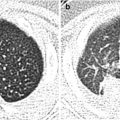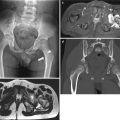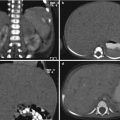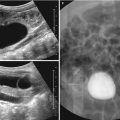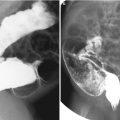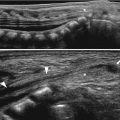Classification
Site of regression
Atresia
1. Left aortic arch
(a) Normal anatomy
R4, R3, Rd
(b) Aberrant right subclavian artery
R2, Rd
(c) Right descending aorta
R2 or R3, Ld
(d) Isolation of right subclavian artery
R4, R2
2. Right aortic arch
(a) Mirror image branching
L4, Rd
(b) Aberrant left subclavian artery
L2, Ld
(c) Right descending aorta
L2 or L3, Rd
(d) Isolation of left subclavian artery
L4, L2
(e) Aberrant left innominate artery
L1, Rd
(f) Isolation of left innominate artery
L4, L1, Rd
3. Double aortic arch
(a) Both arches patent
(b) Atretic left arch
Rd
L4, L3, or L2
(c) Atretic right arch
Ld
R3
18.5.1 Double Aortic Arch
Double aortic arch is formed by persistence of both embryonic fourth aortic arches which encircle the trachea and esophagus completely forming a vascular ring. It is the most common symptomatic vascular ring in infants and young children. It can be subdivided into double aortic arch with both arches patent and that with atretic left aortic arch. In a complete double aortic arch (Fig. 18.9), the ascending aorta bifurcates into the right and left aortic arches that cross over the ipsilateral main bronchus and join to form the descending aorta. The right aortic arch is usually dominant and higher in position than the left aortic arch (Fig. 18.9). In an incomplete double aortic arch (Fig. 18.10), a portion of the left aortic arch is atretic and persists only as a fibrotic or ligamentous connection (Schlesinger et al. 2005).
Chest radiography and esophagography have been used to detect tracheal indentation or posterior esophageal indentation in the patients with double aortic arch. CT angiography is a good imaging modality for evaluating a double aortic arch, especially the incomplete type. The common carotid and subclavian arteries on each side originate separately from the respective aortic arches. Symmetrically located four brachiocephalic arteries on each side above the aortic arch on axial images are suggestive of a double aortic arch as well as other aortic arch anomalies (Figs. 18.9, 18.12, and 18.13).
18.5.2 Left Aortic Arch with an Aberrant Right Subclavian Artery
Left aortic arch with an aberrant right subclavian artery results from anomalous regression of the right fourth aortic arch between the right common carotid and right subclavian arteries. It is the most common aortic arch anomaly with an incidence of 0.5–2 %. The aberrant right subclavian artery arises from the descending aorta as a last branch and crosses the midline by following a retroesophageal course (Fig. 18.11). The aorta thus gives rise to the right carotid, the left carotid, the left subclavian, and the aberrant right subclavian arteries. Aneurysmal dilatation of the origin of the aberrant subclavian artery from the descending aorta can occur, thus forming an aortic diverticulum of Kommerell. Right ductus arteriosus or ligamentum arteriosum with the left aortic arch, aberrant right subclavian artery, and right pulmonary artery may form a loose vascular ring. Esophageal compression by the aberrant right subclavian artery, especially with diverticulum of Kommerell, can manifest as dysphagia in approximately 10 % of adults.
CT angiography with 3-D imaging can accurately evaluate the origin, retroesophageal course of the anomalous subclavian artery, and diverticulum of Kommerell (Turkvatan et al. 2009). It can also evaluate the degree of tracheal compression caused by the vascular ring before surgical division of the ligamentum arteriosum.
18.5.3 Circumflex Left Aortic Arch
Circumflex left aortic arch, also referred to as left aortic arch with right descending aorta, is a rare anomaly in which the aortic arch passes to the left of the trachea and turns to the right behind the esophagus to become the right descending aorta (Philip et al. 2001). The right subclavian artery usually has an anomalous origin from the right descending aorta. Contrary to the aberrant right subclavian artery, the aortic arch itself, not the right subclavian artery, follows a retroesophageal course. The vascular ring is completed by the right ligamentum arteriosum that connects the right pulmonary artery and the right descending aorta with a circumflex aortic arch at the left and posterior sides. However, it is usually loose enough such that it does not cause significant tracheal compression. Esophageal compression often causes dysphagia, which is easily demonstrated by esophagography that shows the large posterior esophageal indentation caused by the retroesophageal aorta.
18.5.4 Right Aortic Arch with an Aberrant Left Subclavian Artery
Right aortic arch with an aberrant left subclavian artery is the mirror image of the left aortic arch with retroesophageal right subclavian artery with a reversed branching sequence. An aberrant left subclavian artery originates as the last branch of the right aortic arch (Fig. 18.12). The aorta gives rise to the left common carotid, the right common carotid, the right subclavian, and the aberrant retroesophageal left subclavian arteries in that order. At its origin from the descending aorta, aneurysmal dilatation can occur, thus forming an aortic diverticulum of Kommerell (Fig. 18.12). When the left-sided ductus or ligament is present, a complete vascular ring is formed with the right aortic arch, aberrant left subclavian artery, and the left pulmonary artery. This anomaly can cause dysphagia, particularly when there is an accompanying large diverticulum of Kommerell or a fibrous band of the left ligamentum arteriosum that results in the formation of a complete vascular ring.
18.5.5 Circumflex Right Aortic Arch
Circumflex right aortic arch, also referred to as right aortic arch with left descending aorta, is analogous to and is the mirror image of the left aortic arch with right descending aorta as described above. In this condition, the aortic arch passes to the right side of the trachea and turns to the left behind the esophagus to become the left descending aorta (Fig. 18.13). The left subclavian artery usually has an anomalous origin directly from the left descending aorta, and hence the left subclavian artery does not have a retroesophageal course. A vascular ring can be formed by the left ligamentum arteriosum that connects the left pulmonary artery and the left descending aorta (Fig. 18.13a), which may cause symptoms. Esophagography can demonstrate the large posterior esophageal indentation caused by the retroesophageal aorta.
18.5.6 Pulmonary Artery Sling
Pulmonary artery sling is a rare congenital anomaly caused by involution of the proximal left sixth aortic arch, in which the left pulmonary artery typically arises from the proximal right pulmonary artery and courses to the left lung between the trachea and esophagus (Fig. 18.14). A sling-like course of an anomalous left pulmonary artery around the distal trachea and carina can result in extrinsic compression of the airways. In addition to extrinsic vascular compression, intrinsic airway abnormalities such as congenital tracheal stenosis due to complete cartilaginous rings or tracheomalacia can be associated with or complicated by the underlying conditions, which can further increase the vascular airway compression. Other concomitant airway anomalies are tracheal bronchus or bridging bronchus.
CT angiography with 3-D imaging can easily demonstrate the course of the pulmonary artery sling and can provide comprehensive anatomical information about the extrinsic airway compression caused by pulmonary artery sling and congenital tracheal stenosis (Lee et al. 2010; Zhong et al. 2010). Accurate diagnosis of the pulmonary artery sling and associated airway abnormalities is required for the selection of appropriate surgical techniques including transposition of the left pulmonary artery and staged or concomitant airway surgery. Complicated tracheomalacia can be accurately diagnosed using paired inspiratory-expiratory CT.
18.5.7 Innominate Artery Compression Syndrome
Innominate artery compression syndrome can occur when the innominate artery originates from the aortic arch in the left side of the mediastinum. It crosses the path of the trachea from the left to right resulting in anterior tracheal compression. However, in most of the children, an anomalous innominate artery results in only a mild degree of tracheal compression and is rarely symptomatic. It can cause symptoms when the narrow space of superior mediastinum is crowded with vascular structures. The airway symptoms of innominate artery compression syndrome are expiratory stridor, cough, and sleep apnea.
CT can easily demonstrate the course of the innominate artery and the degree of tracheal compression on axial and reformatted CT images. Innominate artery compression is highly associated with intrinsic tracheomalacia which can cause or aggravate the respiratory symptoms. Concomitant tracheomalacia can be accurately diagnosed using paired inspiratory-expiratory CT.
18.6 Systemic Venous Anomalies
Anomalies of the systemic veins are rare, and they may occur in isolation or may be associated with cardiac disease. Common systemic venous anomalies are bilateral superior vena cava (SVC) with persistent left SVC, left SVC with mirror image venous drainage, and retroaortic left brachiocephalic vein. Understanding of these anomalies can facilitate the planning and placement of central venous catheters, cardiac pacemaker leads, hemodynamic monitoring devices, and cardioverter-defibrillator leads (Heye et al. 2007).
18.6.1 Persistent Left Superior Vena Cava
Persistent left superior vena cava results from persistence of the left anterior cardinal vein, which yields bilateral SVC or left SVC with mirror image venous drainage. The left SVC usually drains into the right atrium via the coronary sinus, which is dilated due to the overflow from the left SVC (Fig. 18.15). This congenital vascular anomaly is very rare with a reported incidence of 0.3–0.5 % in the general population and an incidence of 1.3–5 % in patients with congenital heart disease. A gateway to the coronary sinus often shows a slit-like stenosis between the left atrial appendage and the left upper pulmonary vein, which is mostly an innocent lesion that does not cause functional obstruction at this level (Fig. 18.15).
18.6.2 Retroaortic Left Brachiocephalic Vein
Retroaortic left brachiocephalic vein, also termed as low innominate vein below the aortic arch, is found in 0.5–0.6 % of patients with congenital heart disease including tetralogy of Fallot, pulmonary atresia with VSD, and truncus arteriosus. It courses posterior to the ascending aorta and underneath the aortic arch, to join the right SVC (Fig. 18.16) (Takada et al. 1992). It does not cause hemodynamic sequelae.
18.7 Pulmonary Venous Anomalies
A common pulmonary vein arises from the dorsal mesocardium and is progressively incorporated into the posterior wall of the left atrium. According to the degree of normal incorporation into the left atrium, variable ostia and branching patterns of the pulmonary vein are formed as a normal variation. Faulty incorporation can give rise to a spectrum of pulmonary venous anomalies, including total anomalous pulmonary venous return (TAPVR), partial anomalous pulmonary venous return (PAPVR), cor triatriatum, sinus venosus defect, and pulmonary venous stenosis. Anomalous pulmonary venous return results from incomplete resorption of the common pulmonary vein and its anastomosis with the primitive venous plexus, along with persistent connections with the systemic cardinal veins. When echocardiography cannot identify all of the pulmonary veins, MR or CT angiography can be used to identify all of the pulmonary veins and to delineate the entire anomalous course (Ucar et al. 2008; Vyas et al. 2012). MR imaging can provide quantitative measurement of the shunt ratio using phase contrast imaging.
18.7.1 Partial Anomalous Pulmonary Venous Return
Partial anomalous pulmonary venous return (PAPVR) represents failure of incorporation of one or more (but not all) of the pulmonary veins into the left atrium. Anomalous pulmonary veins drain instead into the systemic veins, right atrium, or coronary sinus. The most common type of PAPVR is right upper lobe venous drainage into the SVC, which may be associated with a sinus venosus defect. The second most frequent type is the left pulmonary venous drainage into the left innominate vein, followed by anomalous drainage from the right lung into the inferior vena cava (IVC). The last condition is commonly associated with the scimitar syndrome (Fig. 18.17).
Scimitar syndrome is also known as hypogenetic lung syndrome or congenital venolobar syndrome, and in this syndrome, the right pulmonary vein anomalously drains into the IVC via the scimitar vein. The scimitar vein is a curvilinear intrapulmonary vein that resembles the Turkish sword, and it is vertically oriented near the right cardiac border. This syndrome almost exclusively involves the right lung and is associated with hypoplasia of the right lung with secondary dextroposition of the heart. It is commonly associated with more complex pulmonary developmental anomalies including bronchopulmonary sequestration, systemic arterialization of the lung, horseshoe lung, bronchogenic cyst, accessory diaphragm, and congenital diaphragmatic hernia. Horseshoe lung refers to the fusion of lower lobes across the midline to form a horseshoe shape. Chest radiographs can demonstrate the vertically oriented scimitar vein in the right lower lung and right lung hypoplasia (Fig. 18.17a) (Woodring et al. 1994). CT angiography with 3-D rendering is the most useful imaging tool for demonstrating anomalous venous drainage into the IVC, right lung hypoplasia with hypoplastic right pulmonary artery and right bronchus, anomalous systemic arterial supply, and horseshoe lung (Fig. 18.17) (Konen et al. 2003).
Stay updated, free articles. Join our Telegram channel

Full access? Get Clinical Tree


